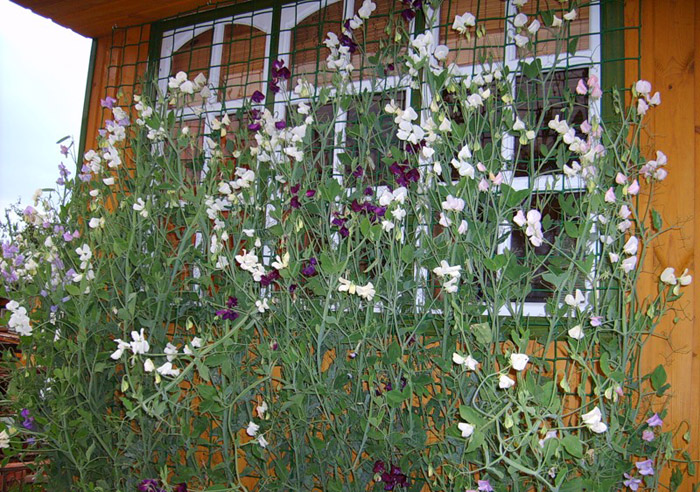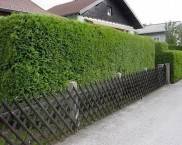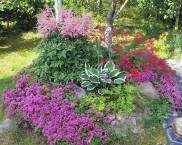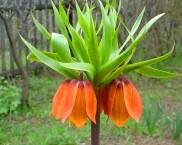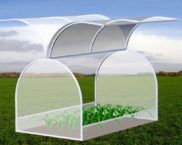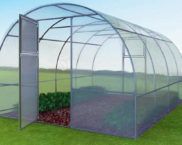Fast growing climbing plants for a fence: how to choose the right and popular varieties
If you want to create an original landscape design on your site, then try using such an unusual element as fast-growing climbing plants for fence... With the help of such crops, magnificent landscaping of the local area is produced. These plants will not only give the hedges an attractive look, but also wonderfully hide the yard from prying eyes. Let's see which plants are best for beautiful fences.
The content of the article
- 1 Fast growing climbing plants for a fence: growing features
- 2 The nuances of choosing fast-growing climbing plants for a summer residence: photos and names
- 2.1 Selection of flowering perennial loaches
- 2.1.1 Actinidia planting and care: photos of beautiful flowers
- 2.1.2 Bougainvillea: growing and care
- 2.1.3 Chinese wisteria: planting and care
- 2.1.4 Decorative curly honeysuckle: types and description
- 2.1.5 Rooting campsis: the nuances of growing
- 2.1.6 Caprifol: photos of luxurious compositions
- 2.1.7 Kirkazon Manchu: secrets of care
- 2.1.8 Clematis: planting and care in the open field
- 2.1.9 Siberian prince: care of culture
- 2.1.10 Schisandra chinensis: cultivation and care
- 2.1.11 White step (bryony): photos of the best compositions
- 2.1.12 Climbing rose: plant photo
- 2.1.13 Mountain ash spiraea: how to grow
- 2.1.14 Ekkremocarpus: the nuances of growing and care
- 2.1.15 Echinocystis: photo of luxurious flowers
- 2.2 How to choose decorative deciduous perennial vines for a fence
- 2.3 Rules for choosing annual climbing plants for a fence
- 2.4 The nuances of choosing climbing shade-loving plants
- 2.1 Selection of flowering perennial loaches
- 3 Secrets of growing perennial climbing plants for a gazebo
Fast growing climbing plants for a fence: growing features
You can create a beautiful flowering hedge yourself without spending a lot of money. Such fences can perform the following functions:
- shelter from prying eyes;
- fencing from animals;
- camouflage of buildings;
- protection from dust, noise and gas pollution;
- can be used for growing berries and fruits;
- restrains the wind and creates a shield for snow.
You can watch interesting ideas in the video below:
When choosing fast-growing climbing perennials, you need to evaluate the following parameters:
- climatic features of a certain area, illumination and location of the site in height;
- the complexity of caring for certain varieties of crops;
- decorative properties.
Climbing plants are popular as a decoration for all kinds of fences. Most often, lush plants are used for suburban areas. In order to choose the right crops, it is worth considering all possible varieties of curly flowers.
Note! A molded or sheared fence consists of plants that are very densely planted. In this case, the crown of shrubs and trees is regularly trimmed. In addition, this option takes up less space.
Climbing perennials
Convenient option for fence - fast-growing climbing plants, especially perennials. Since the most difficult care is required for young seedlings, and then the care procedure is greatly simplified.
Climbing crops most often require shaping and pruning. At first, compulsory care includes a garter, feeding, and watering plants... And some flowers will need a special shelter during the winter. The most popular plants include hops, ivy and grapes. Delphinium is also a common perennial. This plant may require pruning in the future.
Note! The molded version of the hedges does not bloom, since the young shoots are pruned during formation. For such a green space, additional feeding is required, and pruning must be carried out twice a year.
The nuances of choosing fast-growing climbing plants for a summer residence: photos and names
Many decorative annuals are also fast growing and can be used to decorate fences. Popular perennials include hops, which grow rapidly in summer. Also worth noting are honeysuckle and clematis. To provide quality care, they must be tied up, since young shoots grow very quickly.
Before choosing fast growing climbing plants for a fence, keep in mind some important points:
- what the hedge is for;
- plants, what height to choose;
- how much free space are you willing to spend on landscaping;
- single-tiered or multi-tiered hedge.

Weaving compositions can also be arranged in pots. In this case, exotic cultures can also be used. When cold weather comes, you will quickly bring them into the room
Also consider these important conditions:
- type of soil on the site;
- location of moisture;
- how often precipitation falls;
- the area is shaded or sunny;
- how windy it is in your area.
For fences, plants are most often used that can reach a height of up to three meters. It is not necessary to use plants of the same height when creating a hedge. You can try to build a multi-tiered composition. In this case, you need to select plants that will not overshadow each other, and also match in color.

When choosing combinations from plants, it is important to consider the color palette when flowering.
There are cultures that need additional support. For example, a picket fence, a chain-link mesh or a brick wall.Crops that do not require supporting elements can be used to decorate large spaces.
Vines deserve special attention, as they can braid strong structures and trees. These plants go well with small architectural structures such as gazebos, pergolas and arches.
I plant annual crops in early spring, but they live only one season. With their help, you can decorate a small fence. Such plants require careful maintenance. Weaving annuals can be planted not only in open ground, but also on summer cottages or even balconies.
For climbing perennials, special supports are often required. For this, you can use trellis or corners. The best support is a fence.
Note! Free-growing plantings take up much more space, but at the same time they can bloom and bear fruit.
Related article:
The hedge is a fast-growing perennial evergreen. An overview of conifers and deciduous plants for creating a beautiful hedge yourself, examples of beautiful solutions and care tips in a special publication.
Selection of flowering perennial loaches
So let's take a look at popular climbing cultures.
Actinidia planting and care: photos of beautiful flowers
Actinidia is a perennial type liana. The plant is distinguished by beautiful variegated foliage. For the full development of culture, a special support is required. The flowers of this culture are white and odorless. Did you know that actinidia produces delicious fruits that can be eaten fresh. Planting can be done in spring or summer.
There are different varieties of this culture. Let's see what is better than actinidia argut or kolomikt.
Arguta belongs to the most powerful varieties. Its length can reach 30 meters. White inflorescences bloom on the plant. The fruits are spherical. They are quite edible and have a laxative effect.
The main advantage of kolomikta is its resistance to frosty weather. In this case, the plant can reach 10 meters in length. In silt, the leaves turn whitish, and then change the palette from pink to raspberry. And in the fall, the foliage is painted in yellow-pink and red-purple colors.
You can get a better look at this variety in this video:
Both plants can be used for gardening fences. In this case, it is worth considering their size and painting. In addition, the fruit of the arguta will be larger than that of the kolomikta. But many gardeners argue that the latter is more beneficial. Warm climates are more suitable for both varieties.
Note! This culture does not tolerate being near apple trees. Proper crop care is also important, which consists in weeding, pruning and feeding the plants.
Bougainvillea: growing and care
Bougainvillea is a vine, shrub and tree. Not the flowers themselves are decorative, but their flower beds. They can be of various shapes, as well as a color palette: from lilac to white. The most popular varieties are Peruvian, naked and fine. This crop is suitable for cultivation in the southern regions. And in other areas, it can only be grown in pots and taken out into the garden in warm weather. Tubs can be placed near fences, but with the onset of a cold snap, the plant must be removed to a warm room.
When growing such a plant, it is necessary to regulate the growth of shoots. For this, special pruning is used. This procedure can be performed in the fall when the plants are removed to a warmer place. In this case, trimming is done in half. And in the spring, pruning branches by 10 cm will provide better bushiness. During the growing season, a weak growth is removed.
The video shows different types of this culture.
Chinese wisteria: planting and care
Wisteria is a tree-like plant, or rather a liana with clusters of purple, scarlet and white flowers. There are also varieties that are resistant to frost, but in too cold winters, such plants freeze out. Wisteria shoots can cover tall structures such as fences or walls. The culture blooms from May to July, and with proper care in September. The Chinese variety includes several varieties. Most plants are lilac purple in color, but there are also varieties with white double flowers.
Wisteria is often used for vertical landscaping such as fences and walls. It is important for her to provide strong and high-quality supports. All young shoots need to be tied up... Pruning is also used to form the crown.
You can watch the features of growing wisteria in this video:
Note! This culture belongs to the light-loving. The area with this plant should be illuminated for at least 5 - 6 hours a day. Better to plant near the fence, which is located on the south side.
Decorative curly honeysuckle: types and description
In nature, there are more than 250 varieties of honeysuckle. Vertical gardening is done with long vines that can grow up to 5 meters. All ornamental plants have fruits that cannot be eaten. But they have a lot of other advantages. They have luxurious, dense foliage, as well as abundant flowering and bright decorative fruits. With the help of such plants, you can wonderfully decorate any kind of hedges. It should be borne in mind that this culture requires fertile soil.
For fences, you can choose the following varieties of decorative honeysuckle:
- honeysuckle fragrant honeysuckle can climb the fence to a height of 6 meters. This is a hardy version of honeysuckle. Such a plant is photophilous, and also demanding on fertility and moisture. The inflorescences of the plant have a reddish, yellowish and white palette. In this case, the flowering period lasts about 15 days;
- brown honeysuckle can reach 5 meters. The leaves of the culture are elliptical. In this case, the upper part of the leaf is bright green, and the back is bluish. Honeysuckle blooms with gorgeous red flowers. This beautiful period lasts about three weeks;
- honeysuckle henry grows up to 2.5 meters. It blooms with bright pink and brown-red flowers. The plant tolerates shade well;
- Honeysuckle Hekroth along the hedge it can rise to a height of 4 meters. Differs in two-colored inflorescences, which are pink-orange on the outside, and yellowish or cream inside. At the same time, flowering lasts from June to September.
Check out how to grow this amazing crop:
Note! Such species reproduce with the help of layering, cuttings, and also seeds. But the latter method provides a low germination rate.
Rooting campsis: the nuances of growing
There are special secrets when growing rooting campsis. The winter hardiness of this plant allows it to be planted even in cool regions. The plant belongs to deciduous perennial vines. Can climb high on a spacious hedge. At the same time, its shoots twine around the supports in the form of a spiral. Luxurious scarlet and orange tubular flowers form on the stems. Flowering occurs from June to September.
Campsis adheres well to inclined or vertical supports. This is a great solution for decorating a fence. Curly options are excellent for shrub forms.
Note! All sorts of shapes are made from this plant on a frame in the form of pyramids or balls.Such cultures are common in Europe, and in Russia, mostly in the Moscow region.
See how to properly care for your culture:
Caprifol: photos of luxurious compositions
The name of the variety of honeysuckle, honeysuckle, translates as goat leaf. This plant has light green shoots that can turn pinkish-red in the sun. Flowers on tall tubes have a strong aroma. Flowering lasts about a month. This produces orange berries. But they are inedible.
Liana must be planted in sunny areas with a low location of groundwater. In this case, the soil can be light, created on the basis of humus. The honeysuckle is great for shaping. Also, the plant tolerates slight shading well. Plant the vine only in fertile soil that has been pre-moistened. Planting should be done in April, but no later than this month. Reproduction is best done by shoots. If you want to plant several vines at once, then make a small trench. When planting, apply a mulch that will retain moisture and also prevent the spread of weeds.
In order for the plant to develop and grow well, it is necessary to properly prepare the soil. It must be loose so that air can penetrate well into it.
Note! If honeysuckle takes root in you, then dust and environmental conditions are not afraid of it. It will grow for a very long time, about 50 years.
Kirkazon Manchu: secrets of care
Exotic liana flowers Kirkazon will be a wonderful decor for any fence. With proper care, they can grow in our climatic conditions. If you decide to grow them, you need to know that such a culture begins to bloom only in the fifth year.
Maintenance is not difficult, regular watering is important. Do not wait until the top layer of the earth dries up. Formative pruning should be done periodically. At the same time, long shoots that protrude over the hedge must be cut off in time. You also need to remove all dried branches.Planting is best done in the spring or fall. In this case, the seedlings should be 2-3 years old.
A mullein solution is suitable as a top dressing. The culture can be planted in the shade, but it must be provided with sufficient moisture. Watering should be regular, and in case of heat and humidification.
Perfect for a variety of vertical landscaping options. And also for decorating gazebos, arches, balconies and columns.
Note! Caring for such a crop should include mulching and loosening the soil. Half-ripe leaves are suitable as mulch.
Clematis: planting and care in the open field
Clematis also belongs to unpretentious vines. It blooms beautifully and is great for decorating fences. Planting should be done during the spring and preferably in shaded areas. It is also worth choosing a location where groundwater does not pass close to the surface of the earth. You can plant the plant on a small mound.
In case of cold snaps, the plantations need to be covered to prevent them from freezing. Remember to remove the weeds around the bushes as they take up all the moisture you need. Sow lawn grass around the bushes.
Clematis can also be used to decorate beautiful gazebos. The shrub begins to curl from the stems. It is also used to decorate arches and alpine hills, since this plant can spread in the form of a carpet.
In landscape design, similar crops can be used in combination with other decorative crops. At the same time, you can create original compositions with a complex structure.
How to care for clematis, see below:
Tall varieties twist beautifully around supporting elements. Perfectly combined with roses.You can complement them with rosehip and lilac bushes.
It is recommended to plant a crop in the spring. In this case, the distance between the processes should be about a meter. Consider a quality drainage system that protects the seedlings from root rot. Also remove weakened shoots in time.
Note! Inspect the roots before planting seedlings. If they look a little dry, then put the bush in water for a couple of hours.
Siberian prince: care of culture
This culture is, above all, popular for its medicinal properties. The Siberian prince is also used to design all kinds of hedges. You can plant a crop both in May and September. In this case, special care should be taken, since the plant has a fragile root system.
There are a number of pests that are dangerous to this crop. For example, slugs. They must be removed manually. Damaged branches should be removed.
You can see the features of this culture below:
Schisandra chinensis: cultivation and care
Newbies in the gardening business are afraid to take on the cultivation of this crop. But experienced gardeners say that there is nothing difficult about this. And you just need to follow certain rules:
- culture requires at least 8 hours of lighting per day, so it is so important to choose an open area;
- the plant reacts poorly to windy weather, as this may cause various diseases;
- since the plant is climbing, it is important that supports are located nearby, for which it will be attached.
For lemongrass, special care is also needed, including pruning, crown formation and shoot garters.
You can learn the secrets of caring for lemongrass from the video below:
White step (bryony): photos of the best compositions
White Bryony is a perennial that is often planted near hedges. In this case, the vines cling to it and rise up.Interestingly, the seeds can be immediately planted in open ground and at the same time before winter. Briony feels good both in the sun and in the shade. In order for the plant to fully develop, moderate watering is necessary. Also, feeding will not interfere. You can use organic or mineral fertilizers.
Important! Consider whether you need this plant on the site, as it is absolutely completely poisonous. Pay special attention to the warning if you have children or pets. But in folk medicine it is used to treat sciatica and gout.
Climbing rose: plant photo
Let's take a look at the peculiarities of planting and caring for a climbing rose, a photo of which you can see on the website. The bushes grow well, and also cover significant areas. This flower prefers good lighting. But it is important that the plantings are not exposed to the sun for a whole day. Do not overfill the plant, and also plant it in swampy areas. As top dressing, it is better to use special solutions of complex fertilizers, which can be sprayed over the leaves. It is best not to apply this procedure during flowering periods.When planting seedlings, it is recommended to step back from the fences by half a meter.
This is how it is grown:
Note! With the help of a climbing rose, you can disguise the ugly facades of buildings, as well as decorate an old tree. This is an excellent solution for territory zoning. You can braid with roses canopy frame or a gazebo.
Mountain ash spiraea: how to grow
The mountain ash spirea represents a decorative culture that appeared in the Far East. The plant grows in a short time, but its height rarely exceeds two meters. The interlacing of the stems allows you to create dense thickets.
Rowan-leaved spirea is so called because its leaves resemble rowan leaves. The flowering time begins in July and lasts about a month. By autumn, the leaves turn purple and yellowish. You need to plant a bush in a semi-shaded or sunny place. It tolerates drought well, and is also great for watering. Reproduction takes place with the help of root processes.
See what this plant looks like in the video:
Ekkremocarpus: the nuances of growing and care
Ekkremocarpus needs special care as it is not very frost-resistant. The plant is a gorgeous vine with vibrant flowers. Suitable for decorating all kinds of hedges. The culture is distinguished by thin and elegant whips that wrap around the supporting elements well. Such plants can form continuous coatings on fences.
The flowers of this culture are orange and red. It is popular with gardeners for its long bloom that can last up to 2.5 months. An exotic liana looks good on trellises, fences and various arches. Can be used as background and background.
It is grown as an annual plant, as a biennial plant, and also as a perennial crop. In any case, the plant is best planted on the south side of the fence, as it prefers good sunlight. Planting can be done at intervals of 30 cm.
Note! The plant can suffer from aphid attacks. To get rid of this scourge, use a soap solution.
Echinocystis: photo of luxurious flowers
Echinocystis is great for decorating walls and fences. It does not require special care conditions, but the culture is resistant to drought. The plant is able to withstand frost.
People call it mad cucumber. It is quite common in our country and is even grown in cold regions. Liana has stems reaching a length of 6-10 meters. Non-acidic, moisture-permeable and light soils are suitable for echinocystis. In dry weather, watering is necessary, 4-5 liters per bush. Perfectly adapts to specific growing conditions. This plant is also medicinal. It is used in folk medicine because of its strong diuretic, laxative and antihelminthic properties. But at the same time, you need to know the proportions of application, since the plant is considered poisonous.
Look at the video below for the features of growing:
How to choose decorative deciduous perennial vines for a fence
Dekorativno - deciduous vines have the following advantages:
- thickly and quickly braid the fences, and also fill the spans in the fence well;
- caring for such plants is not difficult;
- does not require a lot of soil.
Let's find out which plants are best for a summer cottage.
How to choose plants, see below:
Amur breakthrough grapes: a description of the culture
First of all, an important advantage of the Amur grape is its frost resistance. It is able to withstand even temperatures down to minus 40. This variety grows quickly, and the length of the vine can reach up to 35 meters.
The plant feels good in any soil, but it is better to pick up acidic soil. Sunlight has a beneficial effect on this culture, so it is worth choosing a lit area. When planting seedlings, a distance of 1.5 meters must be observed.
Check out a short overview on this culture:
Girlish grapes: planting and care
The maiden grape includes about 19 varieties. It can grow in the shade, but it can change the color of the leaves to yellow or burgundy. You can plant a crop both in autumn and spring. In this case, it is necessary to maintain a gap of 1 meter. For quality care, it is necessary to trim, as well as shaping... Young shoots must be directed to the fence so that they cling to further development.
Round-leaved woodworm: photo of flowers
The round-leaved woodworm is also represented by vines. In this case, the height of the weaving can reach 12-18 meters. During the season, the plant is able to add from 1 to 2 meters. The perfect solution for fences and fences. For landing, you should choose a well-lit place.
Here is a short video about this plant:
Watering is necessary while the seedlings are young. And so this plant is characterized by resistance to moisture. Pruning is recommended in springtime.
Rules for choosing annual climbing plants for a fence
Decorative annuals for fencing are great for hedges. Such crops can reach significant heights, which allows them to be used as decoration for fences.
Annual crops live only one season, during which they grow foliage and spread throughout the fence. But with the onset of frost, they die. There are some annuals that require minimal maintenance and can even tolerate small frosts. These are ornamental beans and sweet peas.Initially, young shoots must be tied up until they catch on the fences. A netting is ideal.
Sweet pea annual: growing from seed
One-year sweet peas are also common varieties. Planting and care, photos of beautiful decor can be viewed and studied on the site. The process of reproduction of this culture takes place with the help of seeds. In this case, the plants reach a length of two meters.
Peas are endowed with thin stems that are remarkably attached to different fences. You can direct the shoots in the desired direction. There are various varieties of this plant.
Note! Pea inflorescences immediately react to temperature changes. In this case, they may not even appear.
You can see about this culture below:
Ipomoea: planting and care, photo compositions
Morning glory is often used to improve landscape design and hedge decoration. Planting and care in the open field is within the power of even beginners. Vines can reach a height of five meters. Such plantings can perfectly disguise the fence. The decoration is beautiful flowers that can vary in a variety of colors. Flowers open in the morning and cover themselves in the evening.
It is better to plant this plant in May - June, when frosts are no longer expected. You can also use perennial morning glory. Planting and care will differ from annuals.
How to plant imopea correctly, see below:
Ipomoea purple: planting and care, photo of flowers
Ipomoea has a pubescent stem. Planting and caring for the plant is not particularly difficult.The plant can reach a height of about 8 meters. Flowers differ in a varied palette: white, blue and red. There are both terry and variegated colors.
Since annual varieties are native to countries with tropical climates, they do not tolerate frost. Ipomoea should be watered regularly. But at the same time, liquid stagnation in the root system should not be allowed. Top dressing is recommended every 2-3 weeks. Excessive dosage of fertilizers can provoke thick foliage, but flowering will not occur.
Kobeya climbing: growing from seeds
In our review you can see a photo of the Kobei. Planting and leaving a culture requires prior study. This crop can grow up to 6 meters high, especially if it clings to a hedge.The flowers are purple and white in color, and their size can be about 8 cm.
For a plant to grow quickly, it needs a sufficient supply of nutrients. It is also important to provide quality lighting.
Note! Tie young shoots to small supports, and then they themselves will cling to the ledges of the fence.
See how to grow it below:
Curly nasturtium: photo of flowers, how to plant
You can try using nasturtium for decoration. Planting and care is available even for novice gardeners. The plant stems can be up to two meters long. The flowering period of the culture will also delight; it lasts from June to August. Almost any soil is suitable for a plant. Do not overuse organic fertilizing, and also provide the vines with sufficient light.
Growing nasturtium from seeds is especially popular. Many experienced gardeners know when to plant seedlings. It's April or May. The plant does not require special care. Water the sprouts, especially at first.
See How To Grow Nasturtium Correctly:
Decorative beans: the nuances of care
Decorative curly beans are great for decorating hedges. Planting and caring for this crop is not that difficult. A beautiful plant will be a great decoration for any site. If the ornamental beans are properly cared for, the curly stems will grow up to 5 meters in height. Such a culture prefers a lot of light. The decorative option has a large number of varieties. Unlike regular beans, these fruits cannot be consumed as food.
The nuances of choosing climbing shade-loving plants
In addition to such a parameter as light, plants require certain conditions for the soil and for care. There are cultures that thrive in dense shade, and there are vines that need diffused shade.
Garden ivy evergreen: care features
The luxurious design of all kinds of fences involves observing the correct planting and maintenance of garden evergreen ivy. This culture thrives on all types of lighting. It can be planted both in open areas and in semi-shaded areas. While the plant is still young, careful control is required for it, since it can die if it grows too actively.
Note! Ivy is susceptible to many garden diseases. You can learn about the disease by the following symptoms: yellowing and falling foliage, as well as a faded look of vegetation.
Video: how to plant ivy correctly
Hops: planting and care in the open field
Hops are used not only for the production of beer, for medical and food purposes, but also for excellent gardening of fences. Hops are perennials, and their shoots grow very quickly and can grow up to 7 meters.
Common hop is a winter-hardy crop, and it is from its cones that beer wort is produced. The plant is dioecious, that is, there are female and male flowers.
Japanese hops are creeping annuals. It has a more sophisticated look. Unlike the ordinary variety, which winds along the supporting elements, it is able to cover the hedge with a dense and luxurious curtain.Hops grow well. To create a fence, it must be planted at a distance of two meters from the fence. Can decorate arches and all kinds of arbors.
Such a plant feels comfortable in partial shade. In doing so, choose a nutrient soil saturated with humus. It is recommended to cultivate the soil with compost or manure before planting.Find a suitable place near the fence and make a depression about 30 cm. Then the soil must be mixed with compost, and then the seedling should be placed in the depression. In this case, the earthen lump should be at the same level with the ground.
When plaque or stains appear, the affected leaves must be removed, and the plant must be treated with a fungicide. Be sure to help the plant along the fence.To do this, wrap the shoots around the protrusions and supports.
Note! It is recommended to plant hops with other climbing crops. Especially combined with climbing roses.
Related article:
Fences for private houses: photo ideas. In a separate publication, original ideas and examples of fences made of different materials for every taste are presented.
Secrets of growing perennial climbing plants for a gazebo
All the plants that we have considered are suitable not only for a variety of plants, but also for decorating gazebos. If you plant a curly sapling with a structure, then it can grow and gradually cling to the elements of the building.
When choosing a suitable culture, pay attention to the following features:
- placement of the gazebo. The illumination of the adjacent territory is important, as well as soil moisture and windiness of the area;
- decide in advance what density the colors should have. Some grow in dense carpet, while others have gaps;
- perennial or annual. There are crops that can grow for 30 years.
You can choose from a fairly wide range of climbing plants. Moreover, each option requires its own growing conditions. When landscaping a certain area, it is important to decide which area will be made out. It is also recommended to decide on plants that prefer sunny sides. The type of construction or fence matters. For example, a gazebo can be open or closed. And the fence can look like a chain-link, as well as a solid fence or a rather rare structure.
The most versatile plant for a gazebo is ivy. It can rise to the required height, and also creates a dense canopy. You can choose any variegated varieties. This culture is used, both in modern design and in a rural garden or in a regular style.
The maiden grape is characterized by a large scale. It is often used for urban landscaping, as it can reach heights of up to 20 meters. In autumn, the green leaves are replaced with crimson and purple hues.
To plant massive pergolas or gazebos, the woodworm is suitable. It should not be planted near other tree crops. But for a gazebo, intricate counterclockwise twists will come in handy.
Note! Climbing plants, unlike shrubs and trees, can be planted nearby with a fence. In this case, the sprouts should be directed along the fence or arbor.
With a variety of climbing crops, you will give your hedges a complete and unique look. Such landscaping does a great job of camouflaging.




























